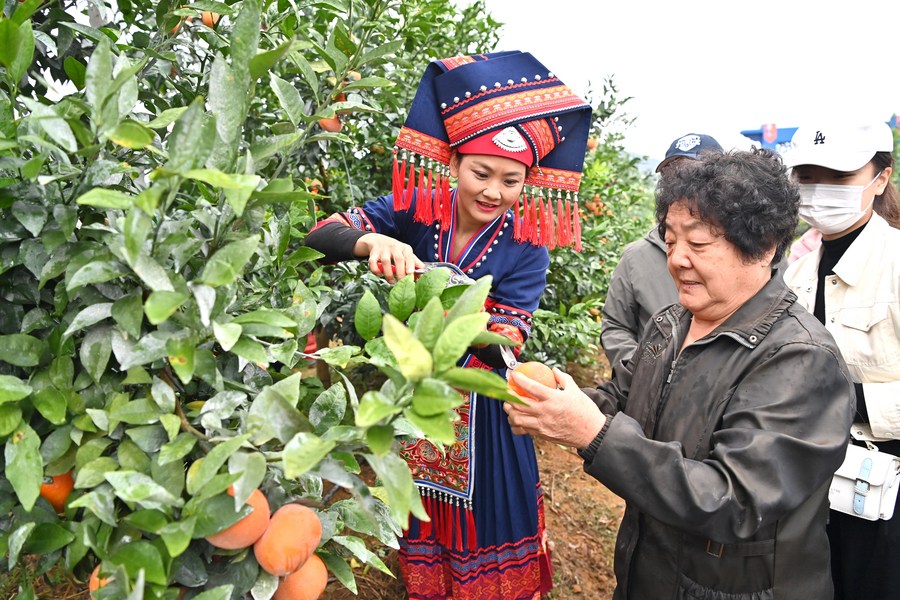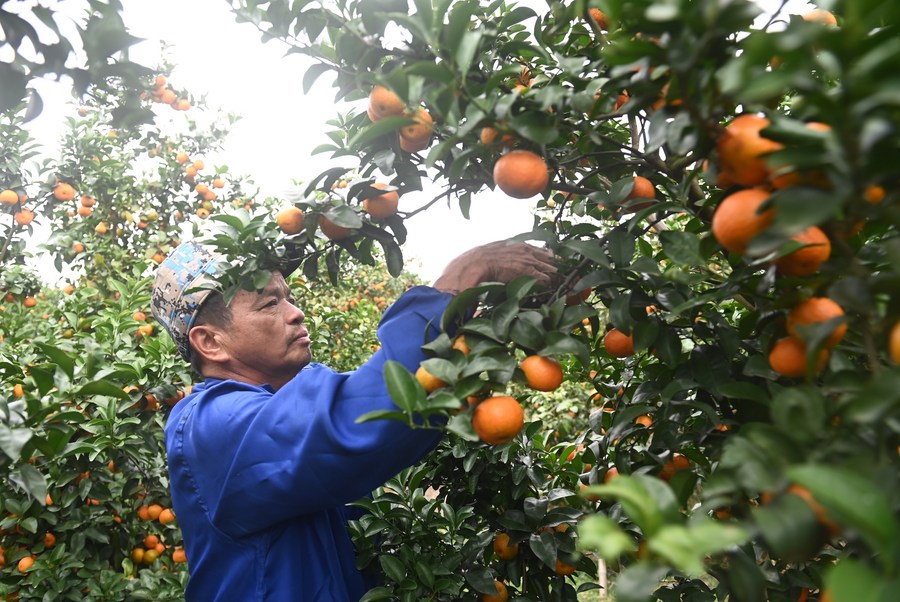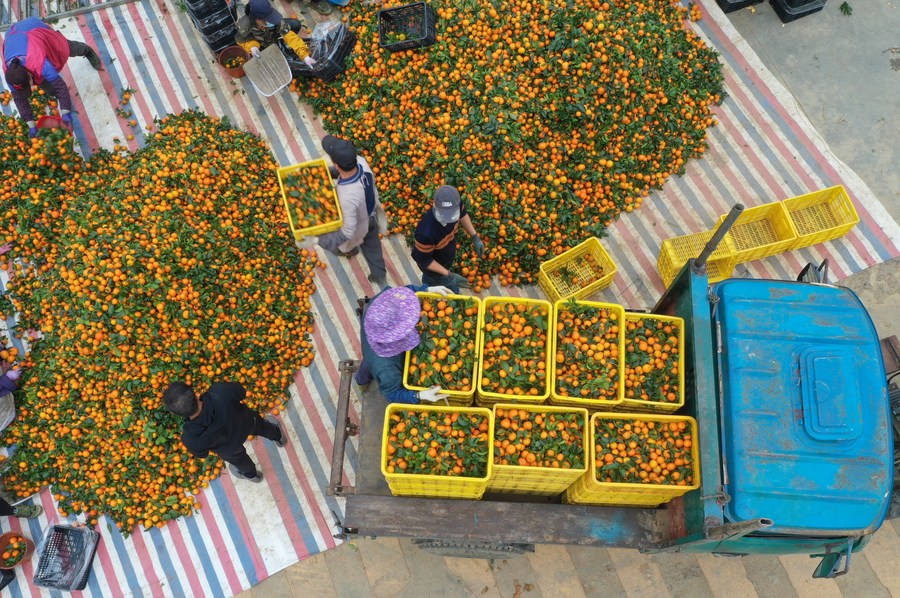South China's Guangxi sees booming fruit exports

A tourist from northeast China picks an orah mandarin with the help of a staff member in Wuming District in Nanning, south China's Guangxi Zhuang Autonomous Region, Jan. 11, 2024. (Xinhua/Zhou Hua)
NANNING, Jan. 21 (Xinhua) -- Nearly 50 tonnes of orah mandarins from Guangxi Mingming Orchard Group were loaded onto ship at the Shenzhen Port, south China's Guangdong Province, and were shipped to Canada on Friday.
"Our orah mandarins started being exported to Canada four years ago. At first, it was mainly to supermarkets in the Chinese quarter. Now we have become the direct supplier of Costco in Canada, and the quality of our orah mandarins has gradually been recognized by the Canadian market," said Ji Sufeng, chairman of Guangxi Mingming Orchard Group in south China's Guangxi Zhuang Autonomous Region.
Ji said that North America, the Middle East and Southeast Asia are the three main international markets for the company's fruit exports.
"In 2023, we exported nearly 1,200 tonnes of orah mandarins," said Ji. "Since January this year, we have exported two containers of the fruit to Thailand and one container to Dubai. In addition to this batch shipping to Canada, these days we have to work overtime to prepare more goods to export to Thailand, Singapore, Malaysia and other Southeast Asian countries."
The company aims to expand the export scale of orah mandarins to 4,000 tonnes in 2024, the chairman added.
Orah mandarin is a thick-skinned citrus fruit that originates in Israel, and which has been planted in Wuming District of Nanning, capital of Guangxi Zhuang Autonomous Region since 2012. Thanks to the unique subtropical monsoon climate and soil conditions, the sweetness of the Wuming orah mandarin is slightly stronger than the sourness, which perfectly meets consumer needs, resulting in a distinct market advantage.

A villager picks "Shatangju" tangerines in Tongfu Village of Xixiangtang District, Nanning, south China's Guangxi Zhuang Autonomous Region, Jan. 5, 2024. (Xinhua/Lu Boan)
Wuming District is the country's largest orah mandarin producing area, boasting over 460,000 mu (about 30,666.7 hectares) production area of the fruit, while its output reached over 1.5 million tonnes in 2023, according to local agricultural authorities.
In recent years, Wuming District has continuously improved the orah mandarin industry chain. It is home to 135 fruit sorting plants and 216 fruit sorting and processing lines, with an annual processing capacity of more than 1 million tonnes of orah mandarins. There are 307 fruit preservation cold storage units with a storage capacity of 150,000 cubic meters, effectively extending the freshness and supply periods of orah mandarins, thus helping the fruit gradually enter the international market.
Data from Nanning Customs shows that there are 94 orchard enterprises with the export qualification for orah mandarins in Guangxi, 26 of which are in Wuming. There are also 58 fruit packaging enterprises with the export qualification, including 20 in Wuming. In 2023, Nanning exported 4,712.8 tonnes of orah mandarins, with a value of about 52.86 million yuan (about 7.43 million U.S. dollars).
Guangxi has good conditions for fruit planting, with abundant rain and sunshine. There are nearly 300 kinds of fruit tree, accounting for 70 percent of the fruit tree species in China.
In 2022, Guangxi's garden fruit planting area exceeded 20 million mu, its fruit output exceeded 30.8 million tonnes, and the total fruit production value exceeded 170 billion yuan, making it a well-known fruit-producing area within China. Guangxi's fruit output for 2023 is expected to achieve the annual target of 33.89 million tonnes, an increase of more than 10 percent year on year.

This aerial photo taken on Jan. 5, 2024 shows villagers unloading "Shatangju" tangerines in Tongfu Village of Xixiangtang District, Nanning, south China's Guangxi Zhuang Autonomous Region. (Xinhua/Lu Boan)
In recent years, with the deepening of economic cooperation and the trade exchange of agricultural products between China and ASEAN, the complementary advantages of agricultural products trade between Guangxi and ASEAN have become more prominent. The geographical advantages of land and sea links with ASEAN have also injected vitality into the continuous expansion of Guangxi's fruit exports.
At Youyiguan Port, in Guangxi's border city of Pingxiang, nearly 20 tonnes of fresh persimmons belonging to Guangxi Shengnong Import and Export Trade Co., Ltd. are to be exported to Vietnam after being inspected by local customs.
"These persimmons we export to Vietnam are all native persimmons produced in the city of Guilin, Guangxi. Since New Year's Day this year, we have exported nearly 300 tonnes of persimmons to Vietnam," said Gao Cuiying, general manager of the company.
Gao added that, with the popularity of Guangxi fruits in Southeast Asian markets, more and more enterprises are engaged in fruit exports in Pingxiang.
According to the data provided by Nanning Customs, in 2023, Guangxi imported 16.71 billion yuan of ASEAN agricultural products, a year-on-year increase of 43.1 percent. At the same time, Guangxi's special fruits, such as orah mandarins and sweet tangerines, have also been well received in the ASEAN market.
In 2023, Guangxi exported 10.71 billion yuan of agricultural products to ASEAN, an annual increase of 1.2 percent. Among them, citrus exports totaled 1.33 billion yuan, an increase of 20.7 percent year on year.
- China, Cambodia pledge to build community with shared future, promote multilateralism, economic globalization
- World Insights: Intensive China visits by ASEAN officials testament to closer ties
- China ready to work with neighboring countries to expand convergence of interests: spokesperson
- Interview: China-ASEAN economic, trade links inseparable: UOB China executive
- UAE to participate in 21st China-ASEAN Expo as special partner

